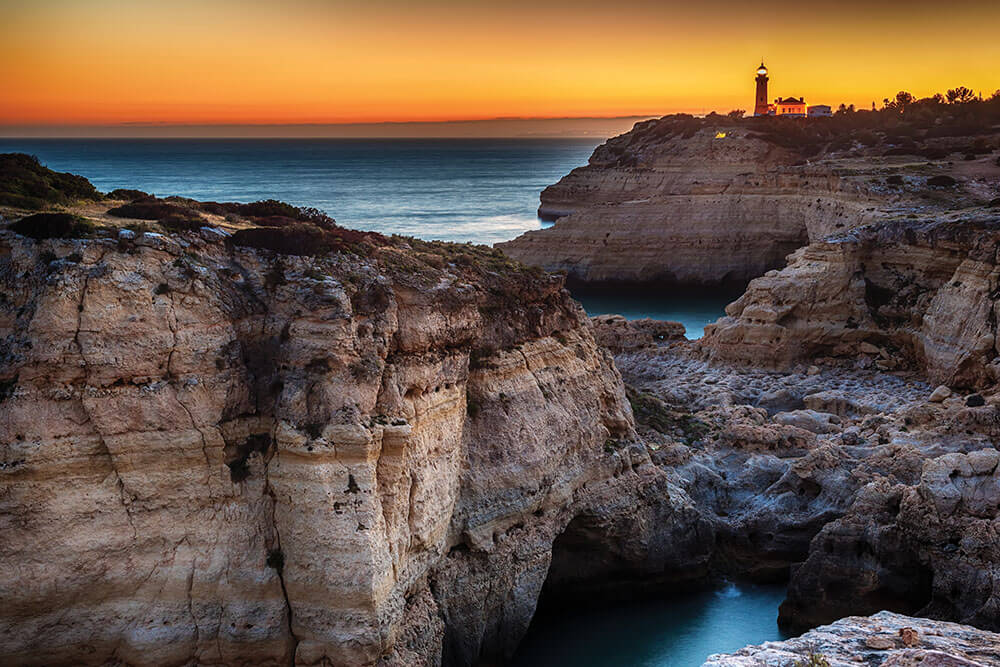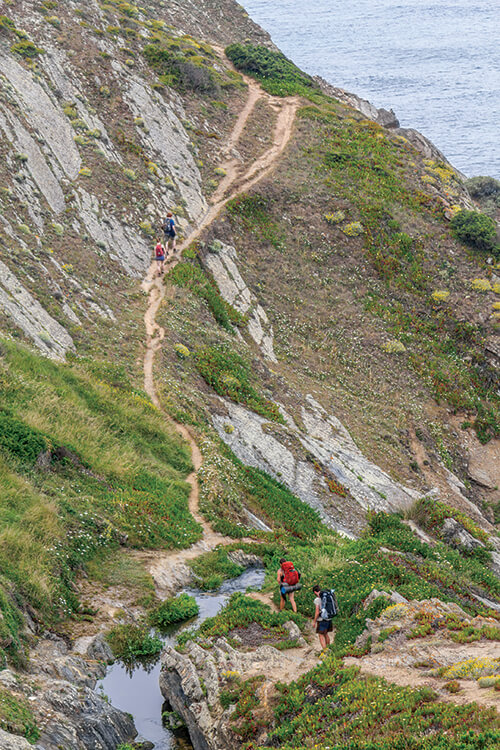
Everyone knows how Columbus sailed the ocean blue in 1492. What elementary school doesn’t teach is the discoverability of Portugal today. The southwest coast of Portugal, specifically, is mesmerizingly scenic, but also a throwback in time. Not as distant as famed explorers Vasco de Gama and Magellan who also navigated overseas during the 14th and 15th Centuries, but akin to Europe in the 1970s.
With deserted beaches tucked between rocky bluffs, hiking trails, quaint villages and fresh food, the southwest coast has been dubbed the only remaining stretch of unspoiled coastline in Europe. The water is warm, the landscape wild and the mood mellow, and it’s only two hours south of the picturesque and friendly capital of Lisbon.
With a total of 586 miles of Atlantic Ocean coastline, Portuguese lifestyle is defined by its sea-faring roots. The southerly regions, named the Alentejo and Algarve, are idyllic vacation retreats. Once summer comes and goes, the place becomes secluded. Traffic is minimal on trails that meander through uncultivated fields of wildflowers, climb atop dramatic seaside cliffs and arrive at charming fishing ports.
The mild Mediterranean climate means “Mom” doesn’t need to tell you to go out and play. The obvious choice is to be afoot on the historic Fisherman’s Trail or surfing some of Europe’s best waves. When day turns to night, sip on a Sagres beer, snack on native seafood, fruits and veggies and savor the serenity, with only the slight distraction of a donkey clopping through the streets.
Trails for fishermen, hikes for fun: Treks
 Ryder-Walker’s seven-night, six-day southwest Portugal trip capitalizes on the fine weather and quiet crowds of early fall. While sunny skies are no guarantee, the raw beauty of the coast is constant. Traveling North to South, the journey begins in Vila Nova de Milfontes in the heart of the Alentejo region.
Ryder-Walker’s seven-night, six-day southwest Portugal trip capitalizes on the fine weather and quiet crowds of early fall. While sunny skies are no guarantee, the raw beauty of the coast is constant. Traveling North to South, the journey begins in Vila Nova de Milfontes in the heart of the Alentejo region.
Meet your Ryder-Walker guides and get ready to walk from town to town with convenient luggage transfers. The first four days of the hiking follow portions of the 47-mile-long Fisherman’s Trail. The coastal route is remote, but also passes through pleasant port towns. Within the Parque Natural do Sudoeste Alentejano e Costa Vicentina, the protected 60-mile coastal stretch showcases the region’s natural dunes, beaches and coves.
Day two begins in Porto Covo at the official start of the Fisherman’s Trail. A ten-mile hike hugs the coastline, followed by three similarly spectacular days with nightly stops at first-class hotels and cozy inns. Averaging 10 miles a day with roughly 800 feet of vertical, the sea level hikes are refreshing, but also deserving of post-hike festivity.
Hiking Highlights
Hiking highlights include: seaside vegetation of Eucalyptus and Pine, more than 20 species of birds including Peregrine Falcons and White Storks, lunch in the cute town of Cavaleiro, and finally, the fifth day’s 11-mile route to Odeceixe, a picture-perfect beach next to the Rio de Seixe and the finishing point of the Fisherman’s Trail.
Here, travel transitions to the Algarve region with a quick 50-minute drive south. On day six, hike in the rural countryside exploring one of 24 different Circular Routes in the area. These highly accessible point-to-point loops exceed no more than 10 miles and are part of the 450-mile Rota Vicentina trail system.
The trip concludes with the most classic trail in the Algarve, the Seven Hanging Valleys Trail. This out-and-back trek is seven miles round trip, covering a rugged stretch between Praia da Marinha in the east and Carvoeiro. Peek into caves and listen to the waves. The views are breathtaking, the rock formations exotic and several swimming opportunities show up along the way.
Live like a local: Cities and Towns
With an international airport, Lisbon is a likely arrival point. Only two hours north of Villa Nova de Milfontes, it’s also well worth visiting on either end of your southwest Portugal trip. Travel guides recommend at least three days to tackle the sights of the city at the mouth of the Tagus River.
Easy to navigate, the city is defined by its pastel-colored buildings and decorative tile work. The imposing São Jorge Castle, dating back to 8th Century BC, is crucial to Lisbon’s history, occupied by the Romans and Moors prior to the Portuguese conquest of 1147.
From Lisbon, travel south to Vila Nova de Milfontes for a two-night stay. Founded in 1485 by King John II, “the New Village of a Thousand Fountains,” as translated, alludes to the numerous natural springs in the area. The town, population 5,000, is striking with coastal walks and the Mira River. It’s also culturally rich with cobbled alleyways, Moorish architecture, beautiful murals and the 1602 Fort of São Clemente.
Almograve
The tiny resort of Almograve is a welcome resting spot on night three with hospitable people, restaurants and bars. The town’s same-named beach is renowned for its panorama and ever-changing tides. The clifftop town of Zambujeira do Mar also has a sandy beach nestled between rocky outcrops, and the Chapel of Nossa Senhora do Mar with whitewashed exterior, rounded arches and blue-tiled adornment.
Algarve
The southernmost Algarve region is famous for its south-facing 96-mile coastline running west to east. It’s also known for painted pottery and the Ria Formosa Lagoon, a nature preserve that is home to hundreds of species of birds. The capital of the region, Faro, has an international airport.
Lagos
Lagos is an old, walled town with an ornate 18th century church, Igreja Santo Antonio, and baroque castle, Castelo dos Governadores. Steep wooden steps lead down to the beach Praia do Camilo. In addition to hikes nearby, boat rides – available from various outfitters – are another fun way to explore the Algarve’s elaborate caves and sinkholes.
A national pastime: Eating out
Whether you show up sandy-footed from the beach, Portuguese meals promise premium ingredients. Restaurants are casual, cuisine is simple – it’s the food that shines. Alentejo is reputed as Portugal’s culinary soul with farm-to-table meals featuring sheep’s cheese, black pork, porca a alentejana, salt cod, wild mushrooms and asparagus.
Traditional Cuisine
From peppery olives to pudim de ovos, one of many egg desserts, it’s hard to eat the same meal twice. Traditional cuisine is based on pork, lamb and bread, creatively combined in tasty stews called açordas or sopas. Coriander, mint, olive oil, garlic, onions and other aromatic herbs add depth and flavor.
Sizzling frango assado, roast chicken, with spicy piri-piri sauce is also popular. With so many interesting Portuguese ingredients, the perfection of this tender, crispy chicken exemplifies the country’s knack for cooking everything from comfort food to molecular gastronomy.
Seafood
Fish is on every menu: cherne, wreckfish, garoupa, grouper, sardines and salmonetes, red mullet, grilled with olive oil and lemon, served with potatoes and salad. The Algarve has endless seafood offerings. These include dishes such as cataplana de marisco. This is a seafood feast cooked in a copper pan with onions, garlic, tomatoes and chorizo. There are also several Michelin-starred eateries serving favorites like octopus, prawns, lobster, crabs, and tamboril, monkfish, often with an ocean view.
 Breakfast
Breakfast
For breakfast, the Portuguese eat cakes, brioche, croissants, and coffee. Milky coffee like meia de leite are common in the morning. Espresso is common during the rest of the day. Enjoy savory snack options such as bolinhos de bacalhau, salt-cod fish cakes, orelhas de porco, crunchy pig’s ears, and croquettes, deep-fried meat patties.
Wine
More than half of Portugal’s wine comes from Alentejo. The award-winning Adega da Cartuxa wine cellar is worth a visit or a glass of Pêra Manca, Cartuxa or Monte dos Pinheiros. For something stronger, Aguardente de Medronho, is a spirit made from medronho berries growing wild in Alentejo and Algarve. It’s served neat, or with honey, cinnamon and lemon, called a Melosa.
Learn more about Ryder-Walker’s guided Portugal: Southwest Scenic Coastal Coastal Trek.









Comments are closed.